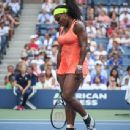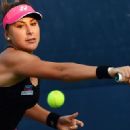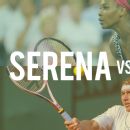TennisNewsNowScoresSchedulePlayersRankingsUS OpenGrand Slam HistoryMore
Comparing Serena Williams to two of the all-time greats
1m - TENNIS SERENA WILLIAMS
 Play5:49
Play5:49
ESPN's Prim Siripipat and Peter Bodo, and legendary tennis coach Nick Bollettieri compare Serena Williams with other great tennis players in history.

Johnette Howard, ESPN Staff Writer
211Shares
Comment
NEW YORK -- Irish author Oscar Wilde, who lived for a time in a London hotel not all that far from Wimbledon, once famously joked, "I can resist everything except temptation" -- a sentiment that comes roaring back to mind as Serena Williams moves closer and closer to finishing off her calendar-year Grand Slam at the US Open, an accomplishment no one has done since Steffi Graf in 1988.
Williams' blanket dominance of today's women's tour tends to make the mind drift toward other greats from other eras. The urge is to try to put her in historical context. She's now generally considered the greatest female player of all time. And still, you wonder ...
How might Serena have done in a head-to-head clash against Graf at her best, or against Martina Navratilova at her best? They're the only two players who can approach Williams' athleticism, longevity and string of accomplishments.
How would Navratilova's serve-and-volley game -- a style pretty much extinct in today's era of souped-up rackets and polyester strings -- survive against the sizzling groundstrokes Williams belts from the backcourt? Better yet, what if you armed Navratilova with the same racket and dropped her down at Wimbledon or the US Open against Serena? Then what?
EDITOR'S PICKS
Isaacson: Serena's nerves not unusual in sports
How does the stress of trying to win a Grand Slam on a world stage affect Serena Williams? As it turns out, not much differently than other athletes.
Garber: Five most likely players to upset Serena Williams
Serena Williams is the overwhelming favorite to win the US Open and complete the calendar Grand Slam, but that didn't stop us from looking at the players who pose as her greatest threats.
By the numbers: Serena Williams vs. Steffi Graf
Serena Williams and Steffi Graf have put together some astounding numbers in their careers. Here's an in-depth look.
"It would be tremendous," says ESPN analyst John McEnroe, a fellow lefty and serve-and-volleyer.
Graf was quiet and inscrutable on the court. Navratilova, like Serena, was emotionally raw and loud (as in loud enough to shatter the wine glasses in the stadium suites if really, really upset.) But once you put the temperament comparisons aside, would Graf's remarkable foot speed and court coverage, her vicious forehand and incinerating will to win make Serena feel great unease at times, as if she was playing a mirror image of herself?
We don't have to ask the same questions about Serena against older sister Venus. They've played 26 times, and Serena has a 15-11 edge in their showdowns and an 8-5 record in their head-to-head meetings at majors.
But Serena versus Navratilova at their absolute bests?
Serena versus Steffi at their absolute bests?
Graf and Williams split their only two meetings, both in 1999. But it's hard to draw much from it because they were at dramatically different stages of their careers. At the start of the year, a 29-year-old Graf beat a 17-year-old Williams in Sydney. Later that spring, Williams beat Graf in three memorable sets in Indian Wells to begin her move out of Venus' considerable shadow. Two months later, Graf won the French Open, the last of her 22 Slams. Three months after that, Williams captured the US Open, the first of her 21.
By then, Navratilova had been retired from singles play five years.
"I would love to play against Serena -- I wish we could have played,"Navratilova once told Laureus.com. "At our best, I think we would pretty much have split the matches. Serena can almost serve you off the court, but once the ball is in play, I think I would be OK. She doesn't like to play people that are fast, which I was, that give her different spins, which I would have.
"She wouldn't have liked to play Steffi Graf because of the low slices and her big serve, and somebody fast that can absorb her power and give it back. They would be great matches."
No argument there.
Graf, meanwhile, has been almost radio silent about Williams' nine-month quest to become only the sixth player to win the Slam. A win here would also tie Williams and Graf at 22 major titles apiece. Graf did speak brieflyabout Williams to France's L'Equipe newspaper while in Paris in June, calling her "a unique athlete" who has "shots and weapons unique in the history of the game."
She also reminisced about the pressure of her own Slam chase, which included an Olympic gold medal as well, and how much it took out of her.
"I remember, above all, the extreme fatigue I felt in New York,'" Graf said. "I was feeling the expectation around me that wasn't mine. That was suffocating and stopping me concentrating.
"Everyone was talking about this chance, and I couldn't understand it. I was 19. I was just relieved when it was finished, and 27 years on, I find it unbelievable to have been able to resist the pressure."
Graf's Grand Slam is a significant piece of her claim to best ever. Four experts we consulted -- ESPN's McEnroe, Cliff Drysdale and Pam Shriver, and Jon Wertheim, an analyst for the Tennis Channel and executive editor at Sports Illustrated -- have some thoughts about how the head-to-head matchups between Williams and Graf and Navratilova would play out.
They disagree on some points. But all of them are in agreement with Chris Evert's opinion that Serena, right here and right now, no matter how this US Open ends, is already the greatest female player of all time.
Evert told Time magazine earlier this summer that she doesn't even buy the argument anymore that Williams has lacked the career-long great rival like she had with Navratilova, or Graf had with Monica Seles until a deranged fan tragically stabbed Seles.
"After watching her [Serena's] matches and watching her closely, these players get close, they're doing really well, and then she'll get to another level where she slaps winners and she starts acing people," Evert said. "It's not one level. All of a sudden, she's up two or three levels better than the field. It's not about the other women. It's about how good Serena is."
Serena versus Martina
Martina Navratilova won 18 career Grand Slam titles, nine of which came at Wimbledon. Georges DeKeerle/Getty Images
McEnroe: "You know, the way the game has changed, Martina and I, we're sort of old school. We look [on video] like we're in slow motion. But both of us would like to think we could translate fairly well if we had the sort of equipment and everything available to us the way it is available to players now.
"Players in the men's and women's game take much bigger swings now. With our racket technology, you couldn't hit the ball as hard. With today's, you're adding a 10 to 20 percent added impact in speed. ... So, I think Martina's serve would've been bigger, and she would've been able to hit her spots even better. In her prime, she was quick-moving to the net, so to think she couldn't do that against Serena would be ludicrous. But she would probably have to pick her spots more."
Drysdale: "They are all great movers and excellent athletes. You're comparing the way the game used to be played with the way it's played now. Today, you'd have a different kind of Martina playing.
"But if you're trying to compare them as players when they were at their best, I'd give the edge strongly to Serena. Martina would try to serve and volley and have minimal success, because Serena's return of serve is just too strong. The only stroke where Martina would be better is the volley, which is considerably better. The issue for Martina is Serena doesn't have to come in much at all. And when she does, she pretty much has the point won."
Shriver: "If everyone had the same equipment, same strings, same chance of power, that would narrow the power differential between Navratilova and, say, Serena of today. So if we're talking apples to apples on equipment and everything else, for any one match, I'd still say Serena can reach a higher level because of her serve and overall power quotient.
"But if you're talking about 10 matches played at their best, or best out of 20 or 50, I'd actually take Navratilova or Graf because they're more consistent over a period of many matches.
"Martina's serve would definitely improve with today's technology. Back then, her serve was more built on being a great serve-and-volleyer and was a lot about enabling her to get to the net as quickly as possible for her first volley. Also, her leftiness -- and that great wide swing serve of hers -- was about getting you off court to set up her next shot. Her intent most of her career was never to hit it as hard a serve as she could ... whereas Serena, and even Graf to [an] extent, their intent was to hit hard. Given Martina's strength, I could see her adapting."
Wertheim: "This is a fun story, but the problem with this is, you end up diminishing these great players. You end up picking apart these great players, and you always get into this: 'What surface are we talking about? Whose technology are we using?' In a vacuum, Serena is the best athlete. Certainly, she's the most powerful.
"Some of this is the technology, but I don't think Martina's serve-and-volley game would be tremendously successful against Serena. We can debate if that's the racket Serena is using or if Martina had Steffi's strings, would that change the dynamic? But serve-and-volley would not be a particularly effective tactic against Serena. I just don't think Martina penetrates the court if Serena hits to her backhand and serves well enough to dictate every rally. Which she can."
Serena versus Steffi
Serena Williams, right, is one Grand Slam win away from tying Steffi Graf's record 22 career titles. Getty Images
McEnroe: "In terms of out-and-out athleticism, the two greatest athletes ever are Steffi and Serena, and maybe Venus close behind. So from that aspect, it would be awesome to see how Serena and Steffi handled each other. Because I practiced with Steffi a lot more than I played with Serena, she was very, very intense and a great person to practice with. And her movement was unbelievable. Serena is also.
"It would be a helluva matchup. It depends what surface, too. You'd think the faster the surface, it would favor Serena because she's got firepower. And Steffi -- because she preferred to chip most of her backhands -- was more comfortable handling the slower surfaces. Her forehand was as big as Serena's. Backhand, you win 22 majors and you get away with chipping 90 percent of your backhands -- that's what Steffi did, what she needed to do.
"In this day and age, if you look at some of the players Serena had great rivalries with, like Justine Henin, I suspect Steffi would have adjusted and used her topspin more often, too, had it been necessary. But when it's not necessary and you're winning pretty much everything, why change a winning formula?"
Drysdale: "Steffi-Serena is a different story than Serena-Martina because Steffi was very strong off the ground. Great athlete. Excellent serve. Not as good a serve as Serena's, which would be the Achilles' heel for Steffi.
"Serena's all-around game the past three years and her groundstrokes have improved. Her forehand has gotten better. Her groundstrokes are equal to Graf's. And I don't see that slice you saw so much of from Graf working in the long run against Serena. She would be able to get to it, she'd be able to use her two-handed backhand and she could slide it down the line. Did I say 'slide'?" Drysdale stops himself, breaking into a laugh -- "I should say she would whack it down the line."
Shriver: "I would have to strongly, strongly disagree with Cliff on the groundstrokes being equal. To me, Graf's forehand -- I don't now if he's talking technology or whatever -- but talk about someone who used her forehand with intimidating intentions, with the intent to hit winners. When Steffi was at her best, her forehand was the best shot in tennis, same as Serena's serve has been now.
"The only real knock on Serena is she just hasn't maintained that highest level of consistent domination over the same amount of time as Navratilova and Graf. And there is also a lot of discussion about the quality of rivals the three of them have had.
"All of them have accomplished things that are superhuman. But again, I'd still say Serena at her best can reach a higher level than any of them at their best for one match."
Navratilova has the most singles titles (167) ever. Graf has more majors (22), but Serena is one away from tying that and could match Graf's calendar-year sweep of the Slams by the time the US Open ends next week. But how do their games match up against each other? Let's evaluate the trio in a few key categories.
Best serve
Graf was no slouch, and Navratilova never went for speed as much as to set up her first volley. Both would benefit from today's improved racket technology. But Williams' serve is the best weapon ever in women's tennis, hands down. Advantage: Williams
Best volley
Graf didn't bother unless forced to, and Williams has nice volleying skills honed by years of doubles play. But Navratilova's awesome anticipation, great hands and athleticism made her net play unmatched. Advantage: Williams
Best forehand
Navratilova's was fine, and Serena's is sensational, but Graf -- whom Bud Collins' famously nicknamed "Fraulein Forehand" -- had the best ever.Advantage: Graf
Best backhand
Graf and Navratilova both made extravagant use of a whispery slice. But when Williams tees off with her two-fisted backhand, she crushes the ball.Advantage: Williams
Best mover
Navratilova's agility was terrific and Graf might win a footrace among the three of them, but she was a baseliner. Serena's court coverage and ability to play up or back are superior. Advantage: Williams
Intangibles
All three women could summon greatness when necessary, but Serena and Martina's emotionally volatility sometimes cost them. Graf rarely beat herself. Advantage: Graf
Isaacson: Venus Williams emulating her dominant days of yore
Considering how dominant Venus Williams was in a straight-sets thumping of Belinda Bencic, it sure feels a lot like the old days.
While the promise of still conditions fired the imagination of some players and some testified it already was a fact of life, Zausner offered a note of caution.
"None of our wind studies indicated a drastic change when all the fabric is installed," he said. "I can't say that the conditions will change a great deal, at least not when the roof is open. Ashe will remain an outdoor stadium."
Perhaps the computer modeling was driven by inadequate data. Or perhaps it failed to give adequate credit to the power of human desire and hope.
As Victoria Azarenka said after playing on Ashe: "It feels a little bit more, as I said, 'cozy' and like a little bit like a bubble. Definitely I think less wind, so there is less traveling of the ball. I love the atmosphere playing there, honestly. This is really exciting to go out there, and what's happening up there, how they are building it, is really impressive."
If this is what the players are saying now, imagine how they will react a year from now when a roof actually exists. And here's a tip: If you're thinking of buying a ticket to next year's event, think east promenade or loge.








No comments:
Post a Comment